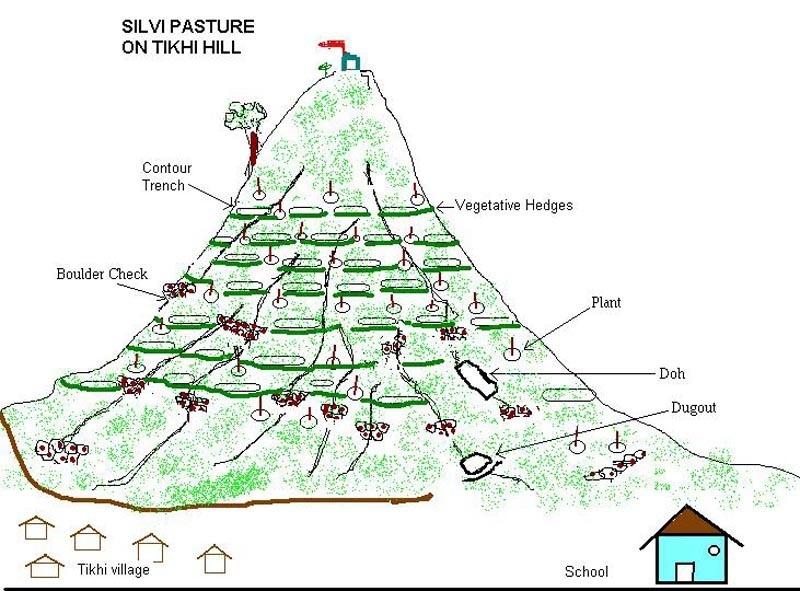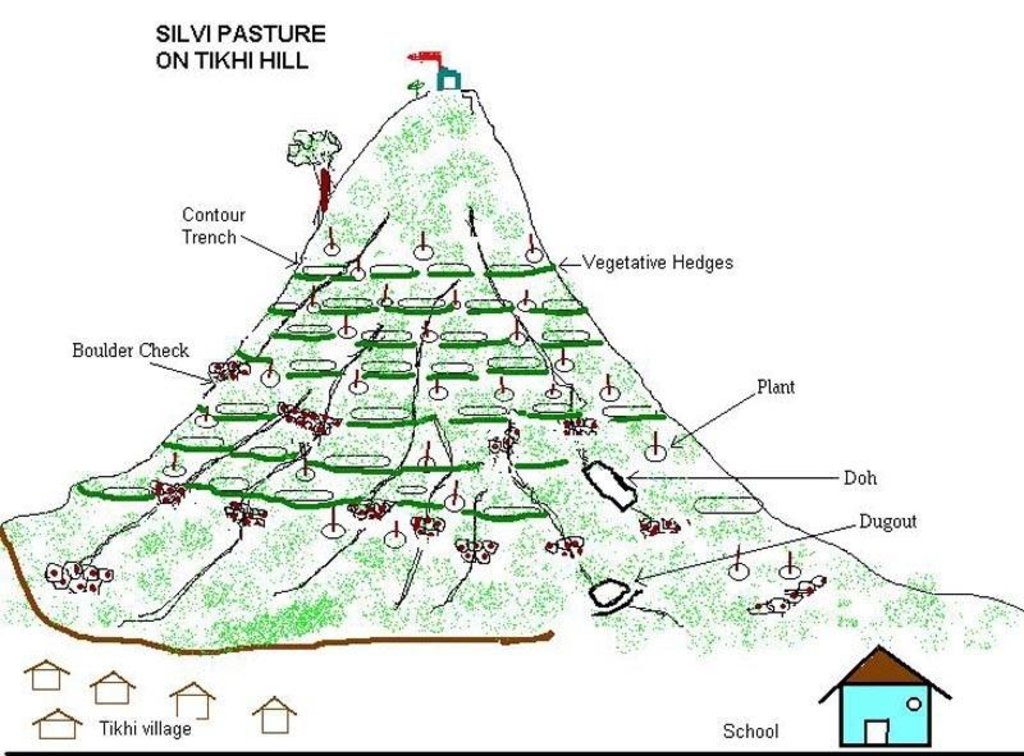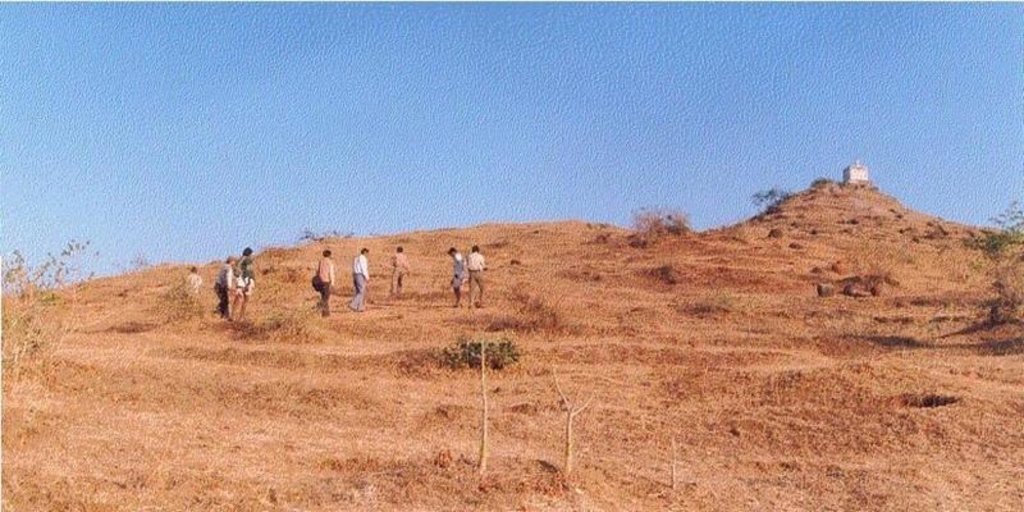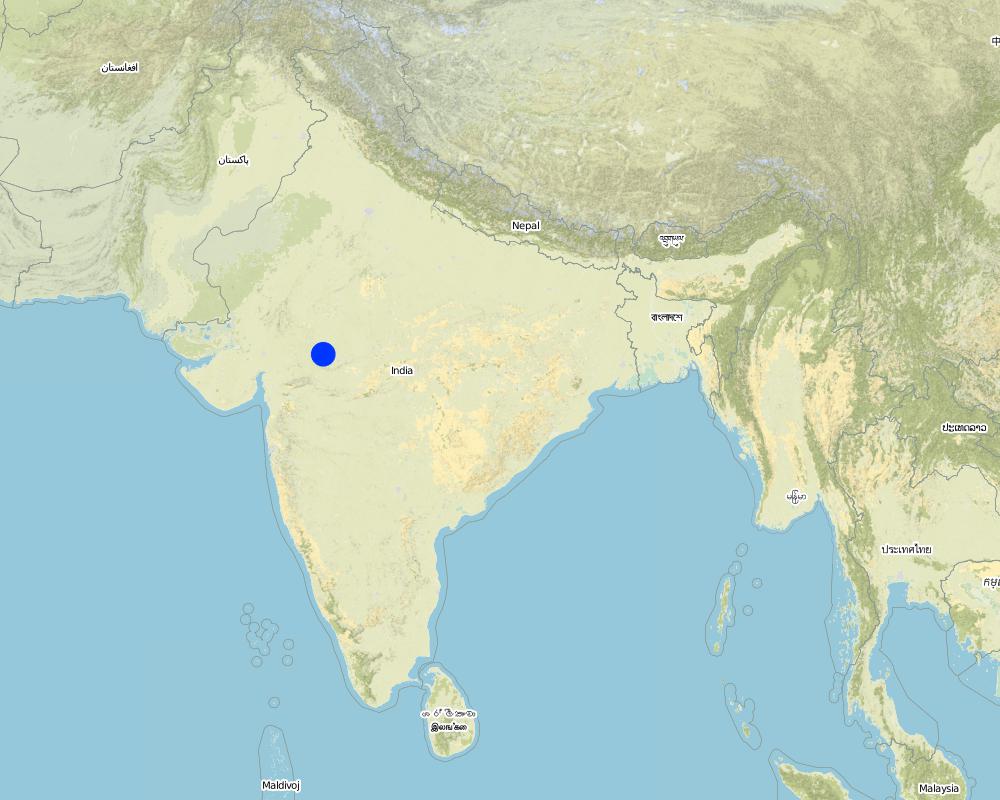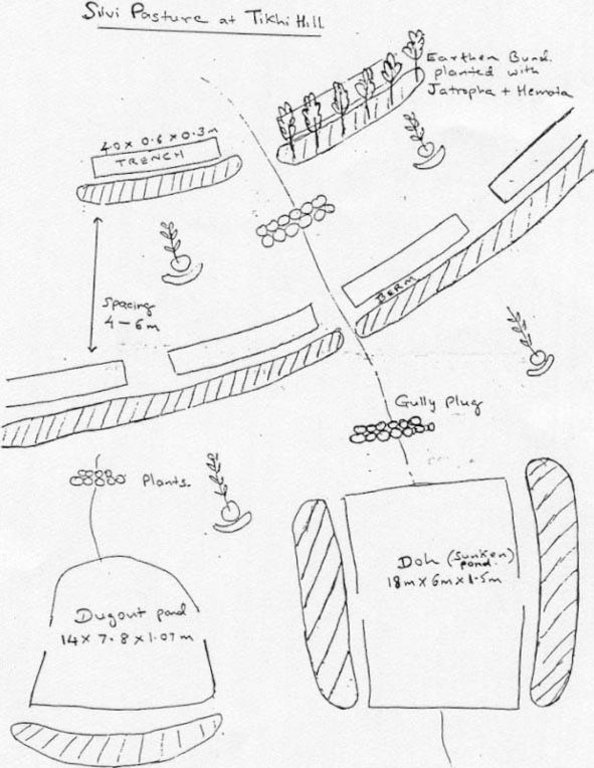Silvi Pasture [الهند]
- تاريخ الإنشاء:
- تحديث:
- جامع المعلومات: Unknown User
- المحرر: –
- المراجعون: Fabian Ottiger, Alexandra Gavilano
Nursery
technologies_1470 - الهند
عرض الأقسام
توسيع الكل طي الكل1. معلومات عامة
1.2 تفاصيل الاتصال بالأشخاص الرئيسيين لمصدر المعلومات والمؤسسات المشاركة في تقييم وتوثيق التقنية
الشخص (الأشخاص) الرئيسي لمصدر المعلومات
متخصص في الإدارة المستدامة للأراضي:
Mewara Ramesh
الهند
1.3 الشروط المتعلقة باستخدام البيانات الموثقة من خلال WOCAT
يوافق جامع المعلومات والشخص (لاشخاص) الرئيسي لمصدر المعلومات على الشروط المتعلقة باستخدام البيانات الموثقة من خلال WOCAT:
نعم
1.5 الإشارة إلى الاستبيان (الاستبيانات) حول مناهج الإدارة المستدامة للأراضي (موثقة باستخدام WOCAT)
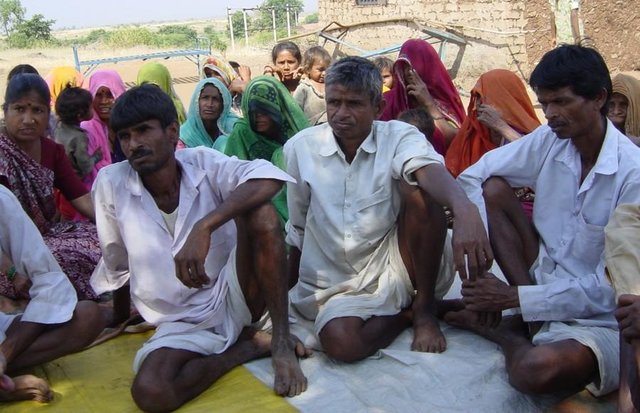
Comprehensive watershed development [الهند]
Participatory approach that includes a package of measures leading to empowerment of communities to implement and sustain watershed development.
- جامع المعلومات: David Gandhi
2. وصف تقنيةالإدارة المستدامي للأراضي
2.1 وصف مختصر للتقنية
تعريف التقنية:
Regeneration of degraded hill side using structural, vegetative & managerial measures.
2.2 وصف تفصيلي للتقنية
الوصف:
Managerial Measures : awareness generation amongst community, users groups, area closure, cut & carry system; Structural Measures :- contour trenches, gully plugs, sunken structure for run off and erosion control; Vegetative Measures :- seeding of grasses and shrubs, plantation of dryland fruit & forest tree species, vegetative barriers across slopes & gullies.
Purpose of the Technology: Short term benefits :- increased fodder availability, increase in well water levels, increased soil moisture in foot hill crop lands; Long term benefits :- environmental regeneration leading to increased production from non-arable & surrounding arable lands.
2.3 صور التقنية
2.5 البلد/المنطقة/المواقع التي تم تنفيذ التقنية فيها والتي يغطيها هذا التقييم
البلد:
الهند
المنطقة/الولاية/المحافظة:
Madhya Pradesh
حدد انتشار التقنية:
- منتشرة بالتساوي على مساحة
إذا كانت التقنيةا موزعة بالتساوي على منطقة ما، حدد المساحة المغطاة (بالكيلومتر المربع):
79,33
إذا كانت المساحة الدقيقة غير معروفة، فيرجى الإشارة إلى المنطقة التقريبية المغطاة:
- 100-10 كم2
التعليقات:
Total area covered by the SLM Technology is 79.33 km2.
The project area comprises 26 villages (2286 HH) mainly tribal. A significant portion of the area is uncultivable waste which is used for open grazing. The technology "Silvi-Pasture" was implemented in few villages to demonstrate an integrated system of SWC and production.
Map
×2.6 تاريخ التنفيذ
في حالة عدم معرفة السنة بالتحديد، يرجى الإشارة إلى التاريخ التقريبي:
- منذ أقل من 10 سنوات (مؤخرًا)
2.7 إدخال التقنية
حدد كيف تم إدخال التقنية:
- من خلال المشاريع/ التدخلات الخارجية
التعليقات (نوع المشروع، الخ):
Learning from visits to successful watershed development projects.
3. تصنيف تقنية الإدارة المستدامي للأراضي
3.1 الغرض الرئيسي ( الأغراض الرئيسية) للتقنية
- تحسين الإنتاج
- الحد من تدهور الأراضي ومنعه وعكسه
3.2 نوع (أنواع) استخدام الأراضي الحالية حيث يتم تطبيق التقنية
استخدامات الأراضي مختلطة ضمن نفس وحدة الأرض:
نعم
حدد استخدام الأراضي المختلطة (المحاصيل / الرعي / الأشجار):
- الرعي الحرجي

الأراضي الزراعية
- زراعة سنوية
- زراعة الأشجار والشجيرات
الزراعة السنوية - حدد المحاصيل:
- محاصيل الأعلاف - الأعشاب
زراعة الأشجار والشجيرات -حدد المحاصيل:
- فواكه أخرى
عدد مواسم الزراعة في السنة:
- 2
حدد:
Longest growing period in days: 120 Longest growing period from month to month: Jun - Oct Second longest growing period in days: 120 Second longest growing period from month to month: Nov - Mar

أراضي الرعي
الرعي المكثف/ إنتاج الأعلاف:
- قطع وحمل / صفر مرعى

الغابات/ الأراضي الحرجية
نوع الشجرة:
- شجرة النيم Azadirachta indica
- Jatropha, Salai (cf. Boswellia serrata), Lantana
التعليقات:
Major land use problems (compiler’s opinion): Grass land :- Degradation due to over grazing; Crop Land :- Low yeilds due to erosion, low soil moisture, improper cultivation practices on sloping lands.
Major land use problems (land users’ perception): Low yields of grass and crops
Trees/ shrubs species: Jatropha, Salai, Neem (Azadirachta indica), Lantana
Fruit trees / shrubs species: Awla (goose berry)
Grass species: Stylo Hemata, Dicanthus(Dinanath)
3.4 إمدادات المياه
إمدادات المياه للأرض التي يتم تنفيذ التقنية عليها:
- بعلية
التعليقات:
Water supply: Also mixed rainfed - irrigated
3.5 مجموعةالإدارة المستدامة للأراضي التي تنتمي إليها هذه التقنية
- إغلاق المنطقة (إيقاف الاستخدام، دعم الاصلاح)
- التدابير المتقاطعة للمنحدرات
- إدارة المياه السطحية (الينابيع، الأنهار، البحيرات، البحار)
3.7 الأنواع الرئيسية من تدهور الأراضي التي تناولتها التقنية

تآكل التربة بالمياه
- الوزن(Wt): فقدان التربة السطحية/تآكل السطح
- (Wg):الانجراف الخلجاني/ الخلجان

تدهور المياه
- (Ha): التجفيف
التعليقات:
Main type of degradation addressed: Wt: loss of topsoil / surface erosion
Secondary types of degradation addressed: Wg: gully erosion / gullying, Ha: aridification
Main causes of degradation: other human induced causes (specify) (Social causes - Lack of awareness and mobilisation amongst the communities.), Top down approach (Macro planning rather than micro (village level) planning.)
4. المواصفات الفنية، وأنشطة التنفيذ، والمدخلات، والتكاليف
4.1 الرسم الفني للتقنية
المواصفات الفنية (المتعلقة بالرسم الفني):
Technical Drawing of SWC technology area, Tikhipada
Technical knowledge required for field staff / advisors: moderate
Technical knowledge required for land users: moderate
Main technical functions: control of dispersed runoff: retain / trap
Secondary technical functions: control of raindrop splash, control of concentrated runoff: retain / trap, control of concentrated runoff: impede / retard
Trees/ shrubs species: Jatropha, Salai, Neem, Lantana
Fruit trees / shrubs species: Awla (goose berry)
Grass species: Stylo Hemata, Dicanthus(Dinanath)
Slope (which determines the spacing indicated above): 35.00%
Construction material (earth): Excavation of earth for trenches/ditchs/pans
Construction material (stone): Stone plugs in gullies
Construction material (other): Vegetative support to stone plugs & ditches
Slope (which determines the spacing indicated above): 35%
Vegetation is used for stabilisation of structures.
Change of land use type: land use planning - Silvi Pasture
Change of land use practices / intensity level: land use change - Area Closure
Control / change of species composition: livestock management - Cut & carry system
Other type of management: Management by community( User Group)
المؤلف:
David Gandhi
4.2 معلومات عامة بخصوص حساب المدخلات والتكاليف
عملة أخرى/ عملة وطنية (حدد):
Rupees
إذا كان ذا صلة، وضح سعر الصرف من الدولار الأمريكي إلى العملة المحلية (على سبيل المثال، 1 دولار أمريكي = 79.9 ريال برازيلي): 1 دولار أمريكي =:
48,85
اذكر متوسط تكلفة أجر العمالة المستأجرة في اليوم الواحد:
1.00
4.3 أنشطة التأسيس
| النشاط | التوقيت (الموسم) | |
|---|---|---|
| 1. | Digging of plantation pit | Summer |
| 2. | Procurement of seeds, plants | Before rainy sesion |
| 3. | Sowing of grass & shrub seeds | Before Ist shower |
| 4. | Planting of saplings | After Ist heavy shawer |
| 5. | Survey/Layout | April (summer) |
| 6. | Excavation of ditches | May |
| 7. | Transportation of stones to site | May |
| 8. | Construction of sediment/sand trap | May |
| 9. | Excavation of Pan(Doh) | May 2nd year |
| 10. | Discussion with community & exposure visit | Feb |
| 11. | Formation of users group, meeting, preparation of action plan | March |
| 12. | Establishment of structural measures & training of users group | April-Jun |
| 13. | Establishment of vegetative meassures | July-Sep. |
| 14. | Area Closure | April-Oct. |
| 15. | Harvesting & distribution of grass by users group | Oct.-Nov. |
4.4 التكاليف والمدخلات اللازمة للتأسيس
التعليقات:
Duration of establishment phase: 24 month(s)
4.5 الصيانة/الأنشطة المتكررة
| النشاط | التوقيت/الوتيرة | |
|---|---|---|
| 1. | Weeding , mulching | 2-3 month after planting /Twice in year for Ist 2 year |
| 2. | Watering | Dry season /During prolonged dry spells |
| 3. | Reseeding of grass/shrubs | Before Ist shower /Upto 2 years |
| 4. | Casualty replacement | After Ist heavy shower /Year 1 & II |
| 5. | Repair of breaches in ditches/traps | July-Sep. during mansoon/As required |
| 6. | Construction of additional traps | July-Sep. during mansoon/As required |
| 7. | Desilting of Ditches/traps/Pans | Oct.-Nov. after mansoon/Annually |
| 8. | Refresher training of users group | Seasonally / |
| 9. | Regular meeting of users group | / 3 times/year |
| 10. | "Shramdan" ( Voluntary labour by usersfor maintenance) |
4.6 التكاليف والمدخلات اللازمة للصيانة/للأنشطة المتكررة (سنويًا)
التعليقات:
The treatment covered an area of aroung 10 ha. 1- Contour Trenches - 6000 Rmt. 2- Large Boulder Check - 58 3- Small Boulder Check - 55 4- Dugout - 1 No. 5- Doh - 1 No. Seeding with jatropha, stylo and dinanath. Planting of saplings.
4.7 أهم العوامل المؤثرة على التكاليف
قدم وصفا لأهم العوامل التي تؤثر على التكاليف:
1- Slope : - Due to steep slope , interval between contour trench lines was less; 2- Soil Depth : - Due to stony strata, excavation cost was high; 3- Material : - Boulders were transported from outside. 4- Lead/Lift : - Due to steep slope, labour output was less 5- Drought :- Replantation costs were high
5. البيئة الطبيعية والبشرية
5.1 المناخ
هطول الأمطار السنوي
- < 250 مم
- 251- 500 ملم
- 501 - 750ملم
- 1,000-751 ملم
- 1,500-1,100 ملم
- 2,000-1,500 ملم
- 3,000-2,001 ملم
- 4,000-3,100 ملم
- > 4000 ملم
حدد متوسط هطول الأمطار السنوي (إذا كان معروفًا)، بالملليمتر:
800,00
المواصفات/التعليقات على هطول الأمطار:
However during 1999 to 2002 below average
المنطقة المناخية الزراعية
- شبه قاحلة
- قاحلة
Semi arid (ranked1)
Arid (ranked 2, due to 3 years of below avg. rainfall, signs of desertification eg. thorny species, lowering of water levels in wells are apparent)
5.2 طوبوغرافيا
متوسط الانحدارات:
- مسطح (0-2%)
- بسيط (3-5%)
- معتدل (6-10%)
- متدحرج (11-15%)
- تلال (16-30%)
- شديدة الانحدار(31-60%)
- فائقة الانحدار (>60%)
التضاريس:
- هضاب/سهول
- أثلام مرتفعة
- المنحدرات الجبلية
- منحدرات التلال
- منحدرات في السفوح
- قاع الوادي
المنطقة الارتفاعية:
- 100-0 متر فوق سطح البحر
- 500-101 متر فوق سطح البحر
- 1,000-501 متر فوق سطح البحر
- 1,500-1,001 متر فوق سطح البحر
- 2,000-1,501 متر فوق سطح البحر
- 2,500-2,100 متر فوق سطح البحر
- 3,000-2,501 متر فوق سطح البحر
- 4,000-3,001 متر فوق سطح البحر
- > 4000 متر فوق سطح البحر
التعليقات والمواصفات الإضافية بشأن التضاريس:
Landforms: Hill slopes (ranked 1) and ridges (ranked 2, isolated hillcock)
Slopes on average: Steep (ranked 1, conical Shaped hillock - upper slope > 30%) and hilly (ranked 2, conical Shaped hillock - lower slope < 30%)
5.3 التربة
متوسط عمق التربة:
- ضحل جدًا (0-20 سم)
- ضحلة (21-50 سم)
- متوسطة العمق (51-80 سم)
- عميقة (81-120 سم)
- عميقة جدًا (> 120 سم)
قوام التربة (التربة السطحية):
- خشن / خفيف (رملي)
المواد العضوية في التربة السطحية:
- منخفضة (<1%)
إذا كان متاحًا، قم بإرفاق وصف كامل للتربة أو تحديد المعلومات المتوفرة، على سبيل المثال نوع التربة، الرقم الهيدروجيني/ درجة حموضة التربة، قدرة التبادل الكاتيوني، النيتروجين، الملوحة وما إلى ذلك.
Soil depth on average: Very shallow (highly eroded surface, exposed parent rock)
Soil texture: Coarse/light (weathered fragments(Kopra))
Soil fertility: Very low (absence of soil)
Topsoil organic matter: Low (absence of vegetation)
Soil drainage/infiltration: Poor (high runoff from stony surface)
Soil water storage capacity: Very low (high runoff from stony surface)
5.6 خصائص مستخدمي الأراضي الذين يطبقون التقنية
الدخل من خارج المزرعة:
- 10-50% من جميع الإيرادات
المستوى النسبي للثروة:
- ضعيف جدا
- ضعيف
اذكر الخصائص الأخرى ذات الصلة لمستخدمي الأراضي:
Population density: 50-100 persons/km2
18% of the land users are average wealthy (4 H.H.).
59% of the land users are poor (13 H.H.).
23% of the land users are poor (5 H.H.).
Off-farm income specification: Around 10% of the total income is from paid labour/migration
5.8 ملكية الأراضي، وحقوق استخدام الأراضي، وحقوق استخدام المياه
ملكية الارض:
- مجتمعي/قروي
حقوق استخدام الأراضي:
- مجتمعي (منظم)
6. الآثار والتصريحات الختامية
6.4 تحليل التكلفة والعائد
كيف يمكن مقارنة العوائد نسبة لتكاليف الإنشاء (من وجهة نظر مستخدمي الأراضي)؟
عوائد قصيرة الأجل:
سلبي
عوائد طويلة الأجل:
إيجابي
كيف تتم مقارنة العوائدمع كلفة الصيانة/التكاليف المتكررة (من وجهة نظر مستخدمي الأراضي)؟
عوائد قصيرة الأجل:
إيجابي قليلا
عوائد طويلة الأجل:
إيجابي
6.5 اعتماد التقنية
التعليقات:
15% of land user families have adopted the Technology with external material support
340 land user families have adopted the Technology with external material support
Comments on acceptance with external material support: survey results
There is a little trend towards spontaneous adoption of the Technology
Comments on adoption trend: Elemets of the technology have been adopted by land users eg. SWC, grass improvement. There is tremendous pressure on grass land due to large number of local cattle & goats, migratory herds of camel & sheeps. Hence spontaneous adoption is not observed since community mobilisation is essential as also efforts for user rights.
7. المراجع والروابط
7.1 طرق جمع/مصادر المعلومات
الروابط والوحدات المواضيعية
توسيع الكل طي الكلالروابط

Comprehensive watershed development [الهند]
Participatory approach that includes a package of measures leading to empowerment of communities to implement and sustain watershed development.
- جامع المعلومات: David Gandhi
الوحدات المواضيعية
لا يوجد وحدات مواضيعية


